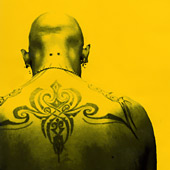Exposures to bloodborne pathogens can happen by getting stuck with a used needle or getting cut by a sharp instrument that has blood on it.
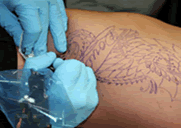 |
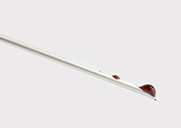 |
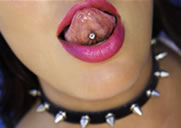 |
Certain practices can reduce needlesticks and other sharps injuries. Here is some additional information for preventing exposures to blood in the body art industry.
-
Disposable piercing needles, tattoo needles, and razors must be
discarded into a sharps disposal container1
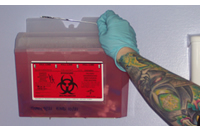
Body artists must throw away used or contaminated sharps into a sharps disposal container.1,2
It is safer to put disposable razors into a
sharps disposal container rather than the trash.
This will protect the person changing or handling the trash bag from getting cut with a used razor.
-
Sharps disposal containers must be kept in a safe place that is easy to reach1
Sharps disposal containers must be kept in a place that is near a work area so artists can quickly and safely dispose of used sharps.1,2 -
Sharps disposal containers must be changed when they become full1
It is a good idea to replace sharps disposal containers when they are 2/3 full.
If sharps disposal containers become full, they must be replaced so the containers do not spill over. An artist could get a needlestick if he or she throws away a sharp item into a full container.
-
Sharps disposal containers must be clearly marked 1,3
Sharps disposal containers must be closeable, puncture resistant, leak-proof, and labeled.1,3These features allow for safe disposal in a container that is familiar to all workers.
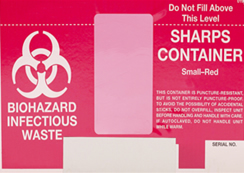
- The number of times an artist’s hands are in contact with a sharp should be reduced if possible
When handling or disposing a used sharp, tattooists and piercers should use a tool instead of their fingers to pick up or hold the sharp.4 This may reduce needlesticks.
- A sharps incident log should be kept for each shop
Though OSHA regulations do not generally require a body artist to keep an injury log, a record of cuts from sharps can increase awareness of sharps-related injuries. A sharps incidence log lets artists know how often sharps-related injuries happen and under what conditions. Recording needlesticks and cuts from sharps allow artists to learn from their mistakes and others' mistakes to help reduce exposures. -
An exposure control
plan must be made and kept at each shop
As required by OSHA, an exposure control plan is written by a shop owner and describes the steps an employer will take to minimize employee exposure to blood.5 The details included in an exposure control plan should be specific to each shop.
The contents of this web page represent recommendations by NIOSH. They draw upon regulations and other materials from the Occupational Safety and Health Administration (OSHA) in the U.S. Department of Labor, upon guidelines by the U.S. Centers for Disease Control and Prevention (CDC), and from findings and recommendations by NIOSH. Sources for these recommendations are cited in footnotes. In considering these NIOSH recommendations, users should also be aware of applicable state and local laws that may impact their implementation.
1 (29 CFR Part 1910.1030) Bloodborne Pathogen Standards. Washington, DC: U.S. Department of Labor, Occupational Safety and Health Administration.
External Link: http://www.osha.gov/pls/oshaweb/owadisp.show_document?p_table=STANDARDS&p_id=10051
2 CDC (Centers for Disease Control and Prevention) [1989]. Guidelines for prevention of transmission of Human Immunodeficiency Virus and Hepatitis B Virus to health-care and public safety workers; A response to P.L. 100-607 The health omnibus program extension act of 1988. MMWR 38(S-6); 3-37.*
3 NIOSH [1998]. Selecting, evaluating and using sharps containers. (PDF) Atlanta, GA: U.S. Department of Health and Human Services, Public Health Service, Centers for Disease Control and Prevention, National Institute for Occupational Safety and Health, DHHS (NIOSH) Publication No. 97-111. *
4 CDC (Centers for Disease Control and Prevention) [2003]. Guidelines for infection control in dental health-care settings. MMWR 52 (RR17-6); 1-61 *
5 OSHA [2003]. Model plans and programs for the OSHA Bloodborne Pathogens and Hazard Communications Standards. U.S. Department of Labor, Occupational Safety and Health Administration.
External Link: http://www.osha.gov/Publications/osha3186.pdf
* This guidance is written for healthcare workers, but may also be relevant to other work settings where contact with blood is possible.
Page last reviewed: November 21, 2007
Content Source: National Institute for Occupational Safety and Health (NIOSH)

